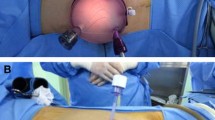Abstract
Background
Live donor nephrectomy is routinely performed. However, little is known regarding the incision-related outcome. The aim of the present study was to evaluate the prevalence of incisional hernias (IH) and to assess body image and cosmesis scores after donation.
Methods
Questionnaires on IH, body image, and cosmesis were sent to all donors who underwent laparoscopic donor nephrectomy or mini-incision donor nephrectomy between January 2000 and December 2009.
Results
In total, 444 replies were received (75 %). Seven donors (1.5 %) had undergone a surgical correction of an IH. Surgical site infection and steroid use appeared to be independent risk factors for the development of an IH (p = 0.001 and 0.021, respectively). Body image and cosmesis scores were excellent. Elderly donors had significantly higher cosmesis scores when compared with young donors (p < 0.001). Donor age of 60 years or higher, correction of an IH, and survival of the recipient appeared to be independent factors associated with a higher score on the cosmesis scale in multivariate analysis.
Conclusions
This is the largest study describing the prevalence of IH and cosmetic outcome after donor nephrectomy. The prevalence of IH after live donor nephrectomy is very low, and body image and cosmesis scores are excellent. Consequently, incision-related outcomes pose no barrier to live donor nephrectomy.


Similar content being viewed by others
References
Mahillo B, Carmona M, Alvarez M, White S, Noel L, Matesanz R (2011) 2009 global data in organ donation and transplantation: activities, laws, and organization. Transplantation 92:1069–1074
Klop KW, Dols LF, Kok NF, Weimar W, IJzermans JN (2012) Attitudes among surgeons towards live-donor nephrectomy: a European update. Transplantation 94(3):263–268
Kok NF, Weimar W, Alwayn IP, IJzermans JN (2006) The current practice of live donor nephrectomy in Europe. Transplantation 82:892–897
Dols LF, IJzermans JN, Wentink N, Tran TC, Zuidema WC, Dooper IM, Weimar W, Kok NF (2010) Long-term follow-up of a randomized trial comparing laparoscopic and mini-incision open live donor nephrectomy. Am J Transplant 10:2481–2487
Kok NF, Lind MY, Hansson BM, Pilzecker D, Mertens zur Borg IR, Knipscheer BC, Hazebroek EJ, Dooper IM, Weimar W, Hop WC, Adang EM, Van der Wilt GJ, Bonjer HJ, van der Vliet JA, IJzermans JN (2006) Comparison of laparoscopic and mini incision open donor nephrectomy: single blind, randomised controlled clinical trial. BMJ 333:221
Nicholson ML, Kaushik M, Lewis GR, Brook NR, Bagul A, Kay MD, Harper SJ, Elwell R, Veitch PS (2010) Randomized clinical trial of laparoscopic versus open donor nephrectomy. Br J Surg 97:21–28
Oyen O, Andersen M, Mathisen L, Kvarstein G, Edwin B, Line PD, Scholz T, Pfeffer PF (2005) Laparoscopic versus open living-donor nephrectomy: experiences from a prospective, randomized, single-center study focusing on donor safety. Transplantation 79:1236–1240
Clemens K, Boudville N, Dew MA, Geddes C, Gill JS, Jassal V, Klarenbach S, Knoll G, Muirhead N, Prasad GV, Storsley L, Treleaven D, Garg AX, Donor Nephrectomy Outcomes Research (DONOR) Network (2011) The long-term quality of life of living kidney donors: a multicenter cohort study. Am J Transplant 11:463–469
Finan KR, Kilgore ML, Hawn MT (2009) Open suture versus mesh repair of primary incisional hernias: a cost-utility analysis. Hernia 13:173–182
Snyder CW, Graham LA, Vick CC, Gray SH, Finan KR, Hawn MT (2011) Patient satisfaction, chronic pain, and quality of life after elective incisional hernia repair: effects of recurrence and repair technique. Hernia 15:123–129
Aboutaleb E, Herbert P, Crane J, Hakim N (2010) Mini-incision donor nephrectomy techniques: a systematic review. Exp Clin Transplant 8:189–195
Diblasio CJ, Snyder ME, Russo P (2006) Mini-flank supra-11th rib incision for open partial or radical nephrectomy. BJU Int 97:149–156
DeSouza A, Domajnko B, Park J, Marecik S, Prasad L, Abcarian H (2011) Incisional hernia, midline versus low transverse incision: What is the ideal incision for specimen extraction and hand-assisted laparoscopy? Surg Endosc 25:1031–1036
Luijendijk RW, Jeekel J, Storm RK, Schutte PJ, Hop WC, Drogendijk AC, Huikeshoven FJ (1997) The low transverse Pfannenstiel incision and the prevalence of incisional hernia and nerve entrapment. Ann Surg 225:365–369
Hussain A, Mahmood H, Singhal T, Balakrishnan S, Nicholls J, El-Hasani S (2009) Long-term study of port-site incisional hernia after laparoscopic procedures. JSLS 13:346–349
Di Lorenzo N, Coscarella G, Lirosi F, Pietrantuono M, Susanna F, Gaspari A (2005) Trocars and hernias: a simple, cheap remedy. Chir Ital 57:87–90
Di Lorenzo N, Coscarella G, Lirosi F, Gaspari A (2002) Port-site closure: a new problem, an old device. JSLS 6:181–183
Dunker MS, Bemelman WA, Slors JF, van Duijvendijk P, Gouma DJ (2001) Functional outcome, quality of life, body image, and cosmesis in patients after laparoscopic-assisted and conventional restorative proctocolectomy: a comparative study. Dis Colon Rectum 44:1800–1807
Dunker MS, Stiggelbout AM, van Hogezand RA, Ringers J, Griffioen G, Bemelman WA (1998) Cosmesis and body image after laparoscopic-assisted and open ileocolic resection for Crohn’s disease. Surg Endosc 12:1334–1340
Lind MY, Hop WC, Weimar W, IJzermans JN (2004) Body image after laparoscopic or open donor nephrectomy. Surg Endosc 18:1276–1279
Hoer J, Lawong G, Klinge U, Schumpelick V (2002) Factors influencing the development of incisional hernia. A retrospective study of 2, 983 laparotomy patients over a period of 10 years. Chirug 73(5):474–480
Disclosures
Karel W. J. Klop, Farah Hussain, Oguzhan Karatepe, Niels F. M. Kok, Jan N. M. IJzermans, and Frank J. M. F. Dor have no conflicts of interest or financial ties to disclose.
Author information
Authors and Affiliations
Corresponding author
Rights and permissions
About this article
Cite this article
Klop, K.W.J., Hussain, F., Karatepe, O. et al. Incision-related outcome after live donor nephrectomy: a single-center experience. Surg Endosc 27, 2801–2806 (2013). https://doi.org/10.1007/s00464-013-2811-0
Received:
Accepted:
Published:
Issue Date:
DOI: https://doi.org/10.1007/s00464-013-2811-0




